PROJ6005: Sustainability in Project Portfolio Management Report
VerifiedAdded on 2021/10/01
|13
|3084
|422
Report
AI Summary
This report provides a comprehensive analysis of project portfolio management (PPM), focusing on IBM Corporation. It begins by evaluating the strategic value of project management and PPM, presenting IBM's approach to portfolio management. The report examines the situational context, including how IBM integrates sustainability into its decision-making processes. It identifies opportunities and threats associated with introducing PPM, such as informed decision-making and resource optimization, as well as challenges like resistance to change and lack of understanding. A detailed plan for PPM implementation is presented, emphasizing strategy, software, and key questions. The report proposes the Project Portfolio Management Maturity Model and recommends Value/Cost Performance measurements as a suitable tool for IBM, offering insights into how to measure project value relative to cost. The analysis covers tools like Strategic Alignment and Continuous Improvement, concluding with actionable recommendations for successful PPM adoption.
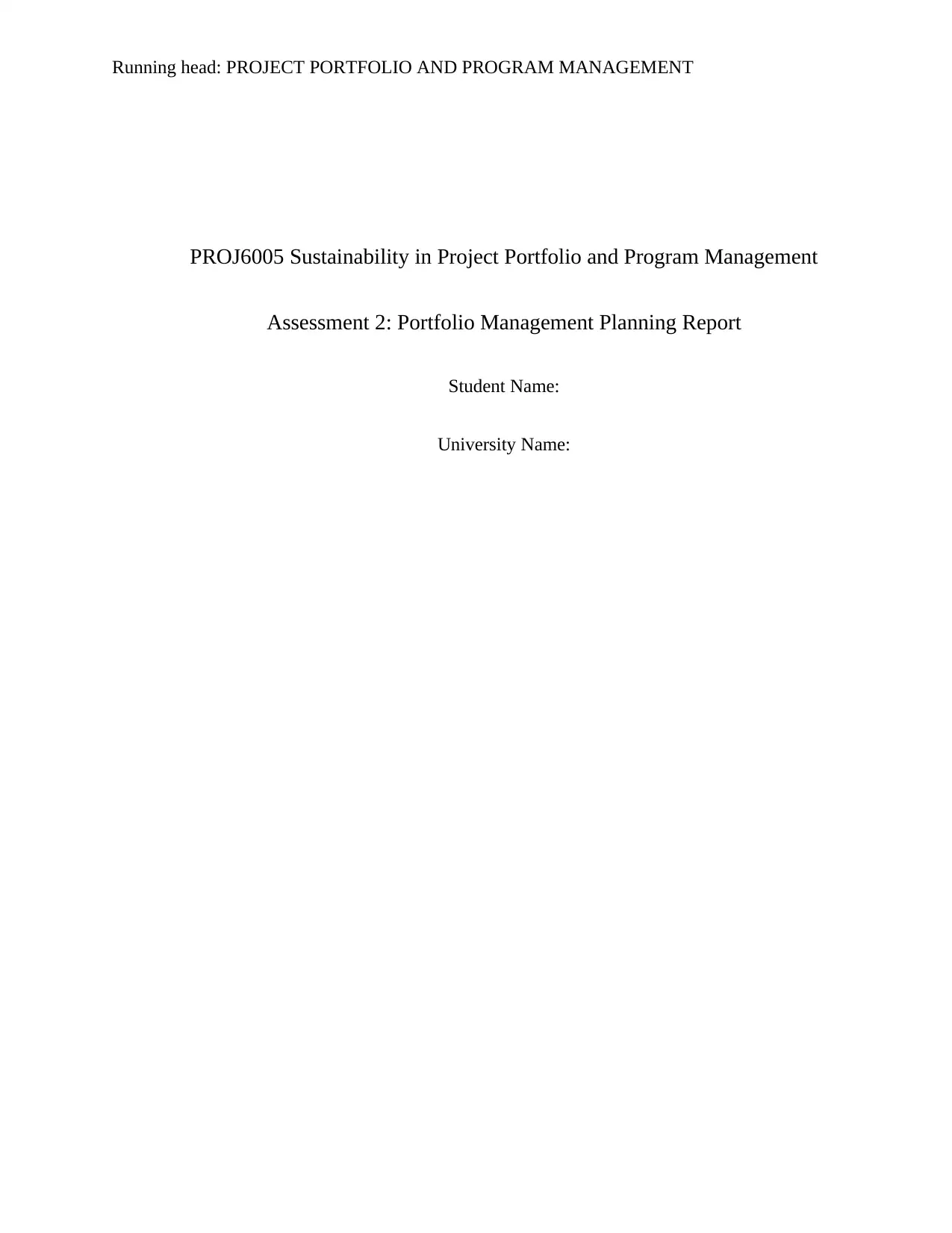
Running head: PROJECT PORTFOLIO AND PROGRAM MANAGEMENT
PROJ6005 Sustainability in Project Portfolio and Program Management
Assessment 2: Portfolio Management Planning Report
Student Name:
University Name:
PROJ6005 Sustainability in Project Portfolio and Program Management
Assessment 2: Portfolio Management Planning Report
Student Name:
University Name:
Paraphrase This Document
Need a fresh take? Get an instant paraphrase of this document with our AI Paraphraser
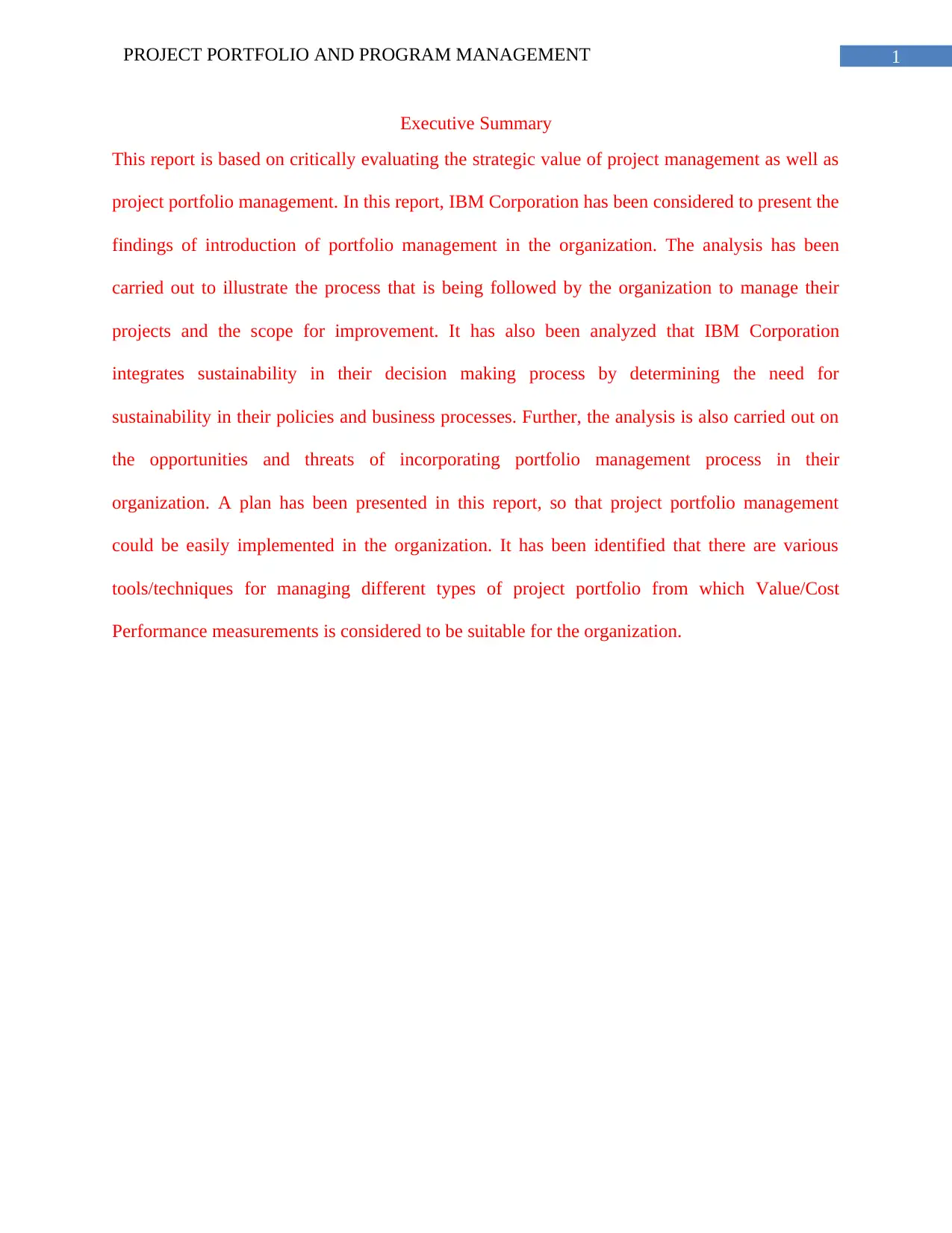
1PROJECT PORTFOLIO AND PROGRAM MANAGEMENT
Executive Summary
This report is based on critically evaluating the strategic value of project management as well as
project portfolio management. In this report, IBM Corporation has been considered to present the
findings of introduction of portfolio management in the organization. The analysis has been
carried out to illustrate the process that is being followed by the organization to manage their
projects and the scope for improvement. It has also been analyzed that IBM Corporation
integrates sustainability in their decision making process by determining the need for
sustainability in their policies and business processes. Further, the analysis is also carried out on
the opportunities and threats of incorporating portfolio management process in their
organization. A plan has been presented in this report, so that project portfolio management
could be easily implemented in the organization. It has been identified that there are various
tools/techniques for managing different types of project portfolio from which Value/Cost
Performance measurements is considered to be suitable for the organization.
Executive Summary
This report is based on critically evaluating the strategic value of project management as well as
project portfolio management. In this report, IBM Corporation has been considered to present the
findings of introduction of portfolio management in the organization. The analysis has been
carried out to illustrate the process that is being followed by the organization to manage their
projects and the scope for improvement. It has also been analyzed that IBM Corporation
integrates sustainability in their decision making process by determining the need for
sustainability in their policies and business processes. Further, the analysis is also carried out on
the opportunities and threats of incorporating portfolio management process in their
organization. A plan has been presented in this report, so that project portfolio management
could be easily implemented in the organization. It has been identified that there are various
tools/techniques for managing different types of project portfolio from which Value/Cost
Performance measurements is considered to be suitable for the organization.
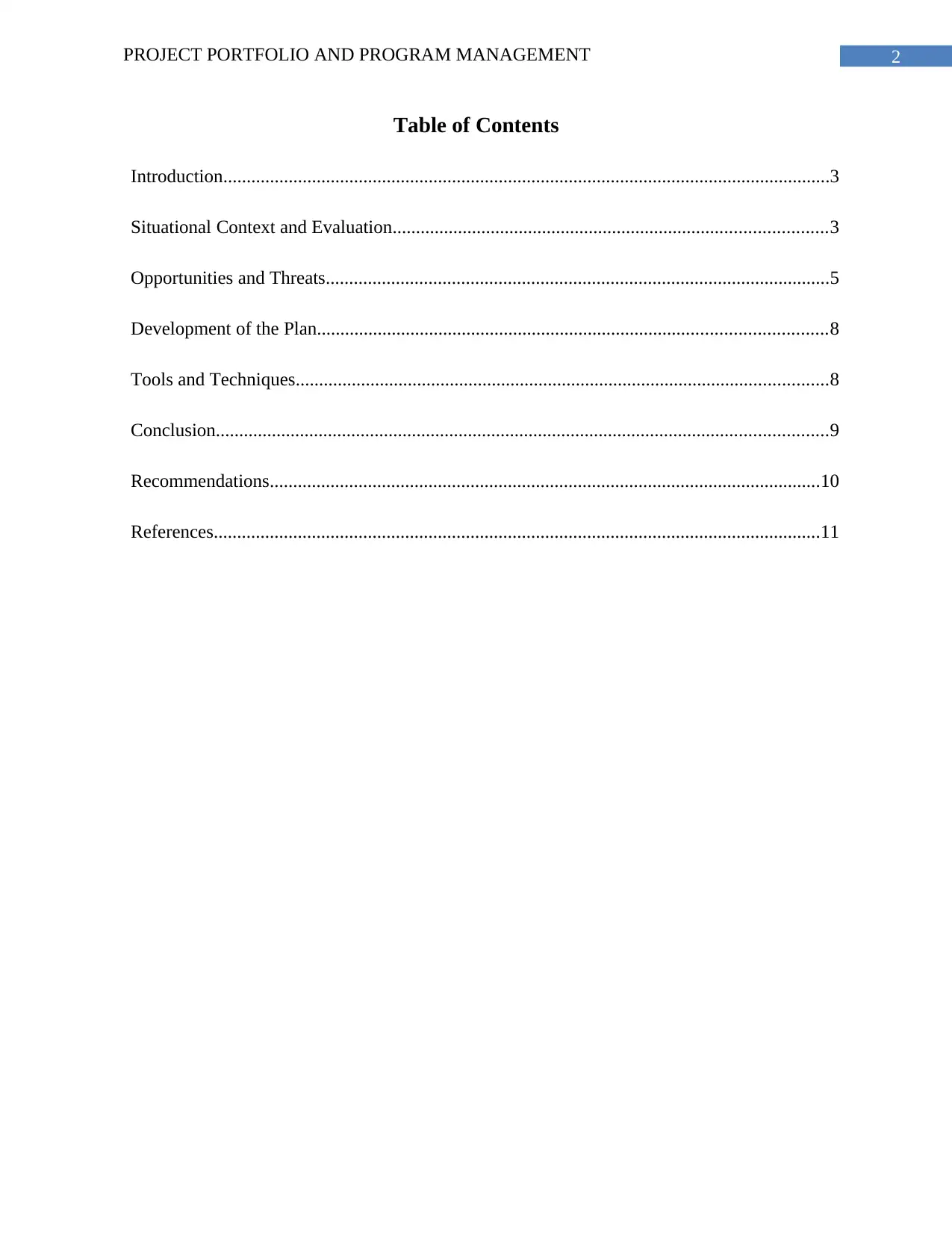
2PROJECT PORTFOLIO AND PROGRAM MANAGEMENT
Table of Contents
Introduction..................................................................................................................................3
Situational Context and Evaluation.............................................................................................3
Opportunities and Threats............................................................................................................5
Development of the Plan.............................................................................................................8
Tools and Techniques..................................................................................................................8
Conclusion...................................................................................................................................9
Recommendations......................................................................................................................10
References..................................................................................................................................11
Table of Contents
Introduction..................................................................................................................................3
Situational Context and Evaluation.............................................................................................3
Opportunities and Threats............................................................................................................5
Development of the Plan.............................................................................................................8
Tools and Techniques..................................................................................................................8
Conclusion...................................................................................................................................9
Recommendations......................................................................................................................10
References..................................................................................................................................11
⊘ This is a preview!⊘
Do you want full access?
Subscribe today to unlock all pages.

Trusted by 1+ million students worldwide
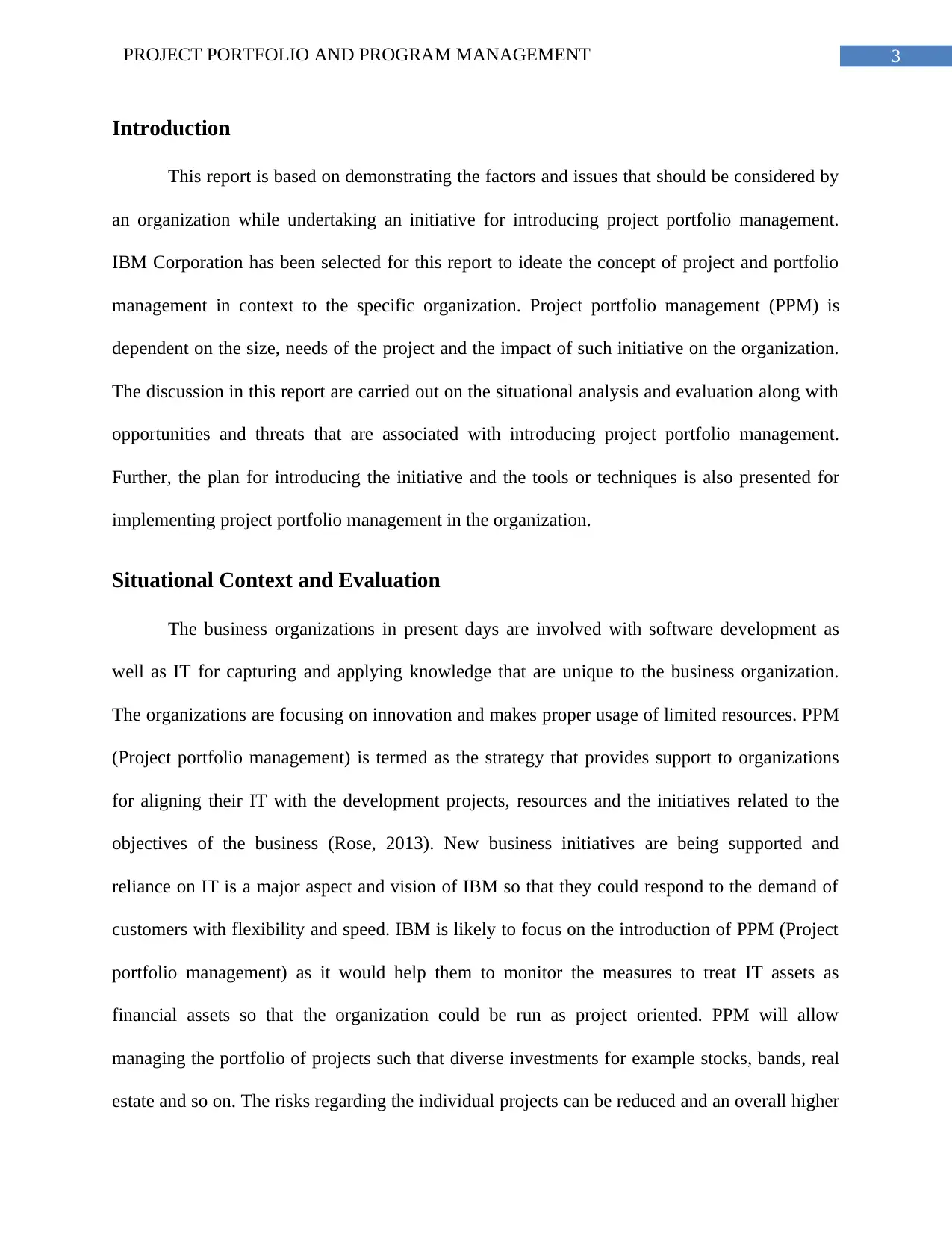
3PROJECT PORTFOLIO AND PROGRAM MANAGEMENT
Introduction
This report is based on demonstrating the factors and issues that should be considered by
an organization while undertaking an initiative for introducing project portfolio management.
IBM Corporation has been selected for this report to ideate the concept of project and portfolio
management in context to the specific organization. Project portfolio management (PPM) is
dependent on the size, needs of the project and the impact of such initiative on the organization.
The discussion in this report are carried out on the situational analysis and evaluation along with
opportunities and threats that are associated with introducing project portfolio management.
Further, the plan for introducing the initiative and the tools or techniques is also presented for
implementing project portfolio management in the organization.
Situational Context and Evaluation
The business organizations in present days are involved with software development as
well as IT for capturing and applying knowledge that are unique to the business organization.
The organizations are focusing on innovation and makes proper usage of limited resources. PPM
(Project portfolio management) is termed as the strategy that provides support to organizations
for aligning their IT with the development projects, resources and the initiatives related to the
objectives of the business (Rose, 2013). New business initiatives are being supported and
reliance on IT is a major aspect and vision of IBM so that they could respond to the demand of
customers with flexibility and speed. IBM is likely to focus on the introduction of PPM (Project
portfolio management) as it would help them to monitor the measures to treat IT assets as
financial assets so that the organization could be run as project oriented. PPM will allow
managing the portfolio of projects such that diverse investments for example stocks, bands, real
estate and so on. The risks regarding the individual projects can be reduced and an overall higher
Introduction
This report is based on demonstrating the factors and issues that should be considered by
an organization while undertaking an initiative for introducing project portfolio management.
IBM Corporation has been selected for this report to ideate the concept of project and portfolio
management in context to the specific organization. Project portfolio management (PPM) is
dependent on the size, needs of the project and the impact of such initiative on the organization.
The discussion in this report are carried out on the situational analysis and evaluation along with
opportunities and threats that are associated with introducing project portfolio management.
Further, the plan for introducing the initiative and the tools or techniques is also presented for
implementing project portfolio management in the organization.
Situational Context and Evaluation
The business organizations in present days are involved with software development as
well as IT for capturing and applying knowledge that are unique to the business organization.
The organizations are focusing on innovation and makes proper usage of limited resources. PPM
(Project portfolio management) is termed as the strategy that provides support to organizations
for aligning their IT with the development projects, resources and the initiatives related to the
objectives of the business (Rose, 2013). New business initiatives are being supported and
reliance on IT is a major aspect and vision of IBM so that they could respond to the demand of
customers with flexibility and speed. IBM is likely to focus on the introduction of PPM (Project
portfolio management) as it would help them to monitor the measures to treat IT assets as
financial assets so that the organization could be run as project oriented. PPM will allow
managing the portfolio of projects such that diverse investments for example stocks, bands, real
estate and so on. The risks regarding the individual projects can be reduced and an overall higher
Paraphrase This Document
Need a fresh take? Get an instant paraphrase of this document with our AI Paraphraser
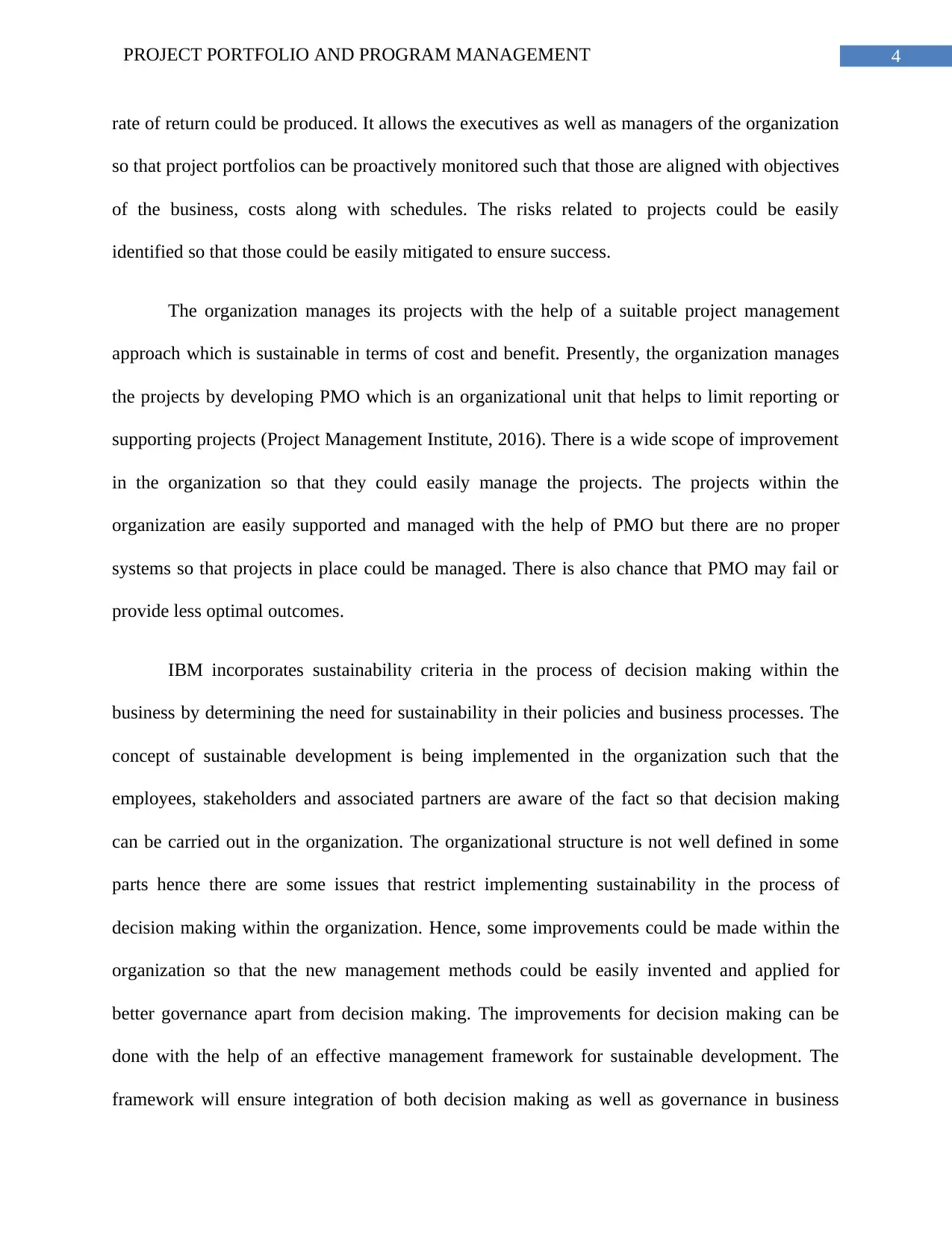
4PROJECT PORTFOLIO AND PROGRAM MANAGEMENT
rate of return could be produced. It allows the executives as well as managers of the organization
so that project portfolios can be proactively monitored such that those are aligned with objectives
of the business, costs along with schedules. The risks related to projects could be easily
identified so that those could be easily mitigated to ensure success.
The organization manages its projects with the help of a suitable project management
approach which is sustainable in terms of cost and benefit. Presently, the organization manages
the projects by developing PMO which is an organizational unit that helps to limit reporting or
supporting projects (Project Management Institute, 2016). There is a wide scope of improvement
in the organization so that they could easily manage the projects. The projects within the
organization are easily supported and managed with the help of PMO but there are no proper
systems so that projects in place could be managed. There is also chance that PMO may fail or
provide less optimal outcomes.
IBM incorporates sustainability criteria in the process of decision making within the
business by determining the need for sustainability in their policies and business processes. The
concept of sustainable development is being implemented in the organization such that the
employees, stakeholders and associated partners are aware of the fact so that decision making
can be carried out in the organization. The organizational structure is not well defined in some
parts hence there are some issues that restrict implementing sustainability in the process of
decision making within the organization. Hence, some improvements could be made within the
organization so that the new management methods could be easily invented and applied for
better governance apart from decision making. The improvements for decision making can be
done with the help of an effective management framework for sustainable development. The
framework will ensure integration of both decision making as well as governance in business
rate of return could be produced. It allows the executives as well as managers of the organization
so that project portfolios can be proactively monitored such that those are aligned with objectives
of the business, costs along with schedules. The risks related to projects could be easily
identified so that those could be easily mitigated to ensure success.
The organization manages its projects with the help of a suitable project management
approach which is sustainable in terms of cost and benefit. Presently, the organization manages
the projects by developing PMO which is an organizational unit that helps to limit reporting or
supporting projects (Project Management Institute, 2016). There is a wide scope of improvement
in the organization so that they could easily manage the projects. The projects within the
organization are easily supported and managed with the help of PMO but there are no proper
systems so that projects in place could be managed. There is also chance that PMO may fail or
provide less optimal outcomes.
IBM incorporates sustainability criteria in the process of decision making within the
business by determining the need for sustainability in their policies and business processes. The
concept of sustainable development is being implemented in the organization such that the
employees, stakeholders and associated partners are aware of the fact so that decision making
can be carried out in the organization. The organizational structure is not well defined in some
parts hence there are some issues that restrict implementing sustainability in the process of
decision making within the organization. Hence, some improvements could be made within the
organization so that the new management methods could be easily invented and applied for
better governance apart from decision making. The improvements for decision making can be
done with the help of an effective management framework for sustainable development. The
framework will ensure integration of both decision making as well as governance in business
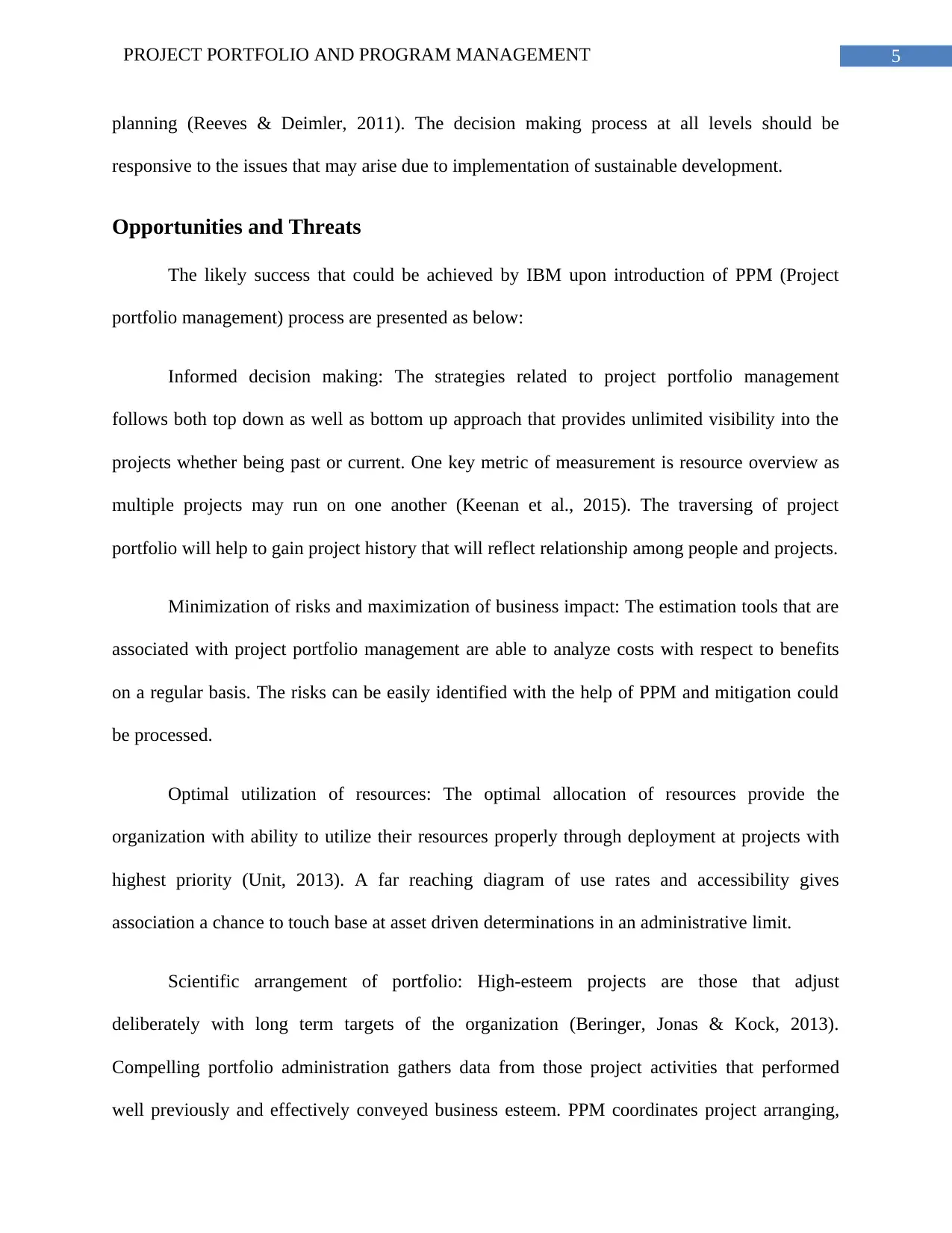
5PROJECT PORTFOLIO AND PROGRAM MANAGEMENT
planning (Reeves & Deimler, 2011). The decision making process at all levels should be
responsive to the issues that may arise due to implementation of sustainable development.
Opportunities and Threats
The likely success that could be achieved by IBM upon introduction of PPM (Project
portfolio management) process are presented as below:
Informed decision making: The strategies related to project portfolio management
follows both top down as well as bottom up approach that provides unlimited visibility into the
projects whether being past or current. One key metric of measurement is resource overview as
multiple projects may run on one another (Keenan et al., 2015). The traversing of project
portfolio will help to gain project history that will reflect relationship among people and projects.
Minimization of risks and maximization of business impact: The estimation tools that are
associated with project portfolio management are able to analyze costs with respect to benefits
on a regular basis. The risks can be easily identified with the help of PPM and mitigation could
be processed.
Optimal utilization of resources: The optimal allocation of resources provide the
organization with ability to utilize their resources properly through deployment at projects with
highest priority (Unit, 2013). A far reaching diagram of use rates and accessibility gives
association a chance to touch base at asset driven determinations in an administrative limit.
Scientific arrangement of portfolio: High-esteem projects are those that adjust
deliberately with long term targets of the organization (Beringer, Jonas & Kock, 2013).
Compelling portfolio administration gathers data from those project activities that performed
well previously and effectively conveyed business esteem. PPM coordinates project arranging,
planning (Reeves & Deimler, 2011). The decision making process at all levels should be
responsive to the issues that may arise due to implementation of sustainable development.
Opportunities and Threats
The likely success that could be achieved by IBM upon introduction of PPM (Project
portfolio management) process are presented as below:
Informed decision making: The strategies related to project portfolio management
follows both top down as well as bottom up approach that provides unlimited visibility into the
projects whether being past or current. One key metric of measurement is resource overview as
multiple projects may run on one another (Keenan et al., 2015). The traversing of project
portfolio will help to gain project history that will reflect relationship among people and projects.
Minimization of risks and maximization of business impact: The estimation tools that are
associated with project portfolio management are able to analyze costs with respect to benefits
on a regular basis. The risks can be easily identified with the help of PPM and mitigation could
be processed.
Optimal utilization of resources: The optimal allocation of resources provide the
organization with ability to utilize their resources properly through deployment at projects with
highest priority (Unit, 2013). A far reaching diagram of use rates and accessibility gives
association a chance to touch base at asset driven determinations in an administrative limit.
Scientific arrangement of portfolio: High-esteem projects are those that adjust
deliberately with long term targets of the organization (Beringer, Jonas & Kock, 2013).
Compelling portfolio administration gathers data from those project activities that performed
well previously and effectively conveyed business esteem. PPM coordinates project arranging,
⊘ This is a preview!⊘
Do you want full access?
Subscribe today to unlock all pages.

Trusted by 1+ million students worldwide
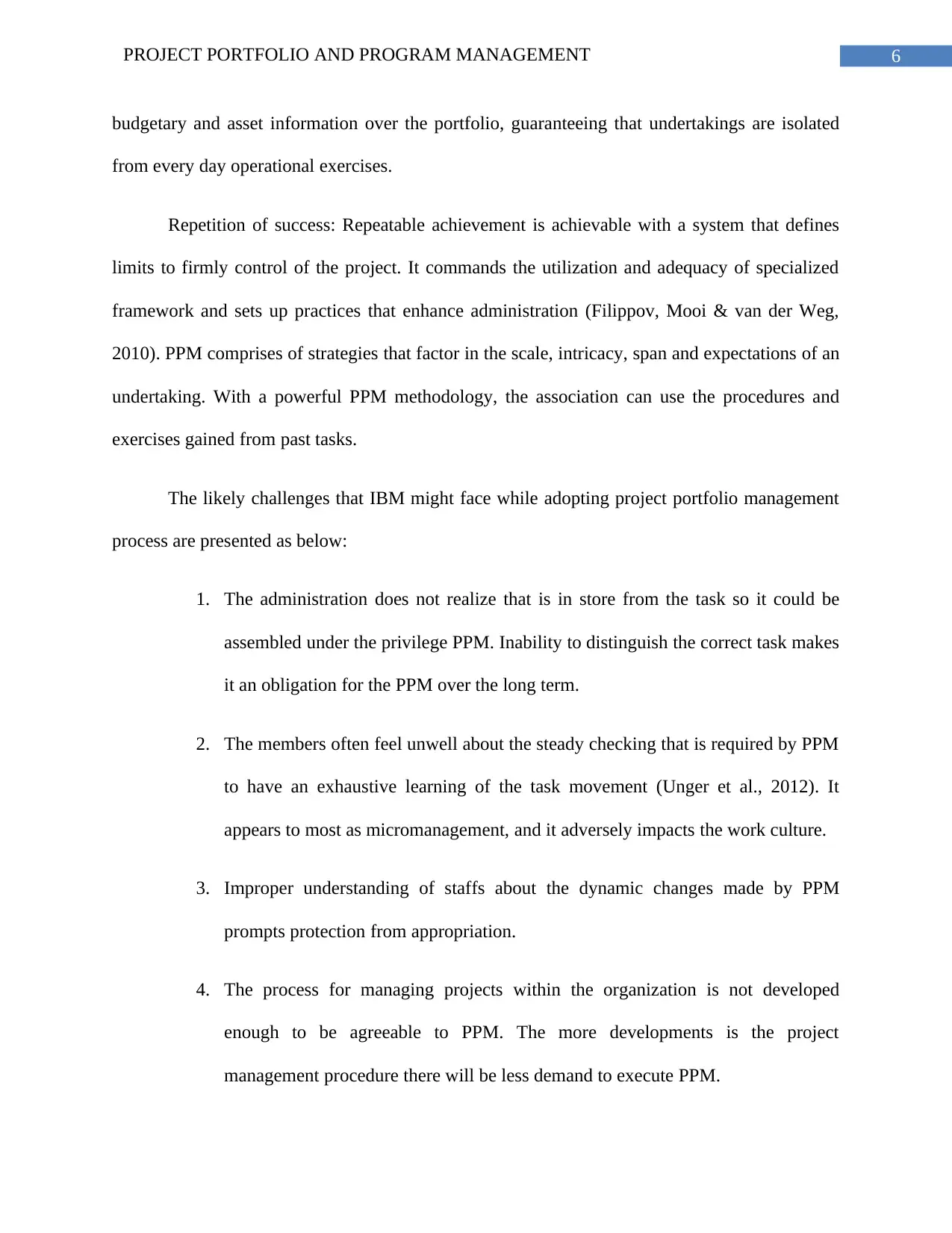
6PROJECT PORTFOLIO AND PROGRAM MANAGEMENT
budgetary and asset information over the portfolio, guaranteeing that undertakings are isolated
from every day operational exercises.
Repetition of success: Repeatable achievement is achievable with a system that defines
limits to firmly control of the project. It commands the utilization and adequacy of specialized
framework and sets up practices that enhance administration (Filippov, Mooi & van der Weg,
2010). PPM comprises of strategies that factor in the scale, intricacy, span and expectations of an
undertaking. With a powerful PPM methodology, the association can use the procedures and
exercises gained from past tasks.
The likely challenges that IBM might face while adopting project portfolio management
process are presented as below:
1. The administration does not realize that is in store from the task so it could be
assembled under the privilege PPM. Inability to distinguish the correct task makes
it an obligation for the PPM over the long term.
2. The members often feel unwell about the steady checking that is required by PPM
to have an exhaustive learning of the task movement (Unger et al., 2012). It
appears to most as micromanagement, and it adversely impacts the work culture.
3. Improper understanding of staffs about the dynamic changes made by PPM
prompts protection from appropriation.
4. The process for managing projects within the organization is not developed
enough to be agreeable to PPM. The more developments is the project
management procedure there will be less demand to execute PPM.
budgetary and asset information over the portfolio, guaranteeing that undertakings are isolated
from every day operational exercises.
Repetition of success: Repeatable achievement is achievable with a system that defines
limits to firmly control of the project. It commands the utilization and adequacy of specialized
framework and sets up practices that enhance administration (Filippov, Mooi & van der Weg,
2010). PPM comprises of strategies that factor in the scale, intricacy, span and expectations of an
undertaking. With a powerful PPM methodology, the association can use the procedures and
exercises gained from past tasks.
The likely challenges that IBM might face while adopting project portfolio management
process are presented as below:
1. The administration does not realize that is in store from the task so it could be
assembled under the privilege PPM. Inability to distinguish the correct task makes
it an obligation for the PPM over the long term.
2. The members often feel unwell about the steady checking that is required by PPM
to have an exhaustive learning of the task movement (Unger et al., 2012). It
appears to most as micromanagement, and it adversely impacts the work culture.
3. Improper understanding of staffs about the dynamic changes made by PPM
prompts protection from appropriation.
4. The process for managing projects within the organization is not developed
enough to be agreeable to PPM. The more developments is the project
management procedure there will be less demand to execute PPM.
Paraphrase This Document
Need a fresh take? Get an instant paraphrase of this document with our AI Paraphraser
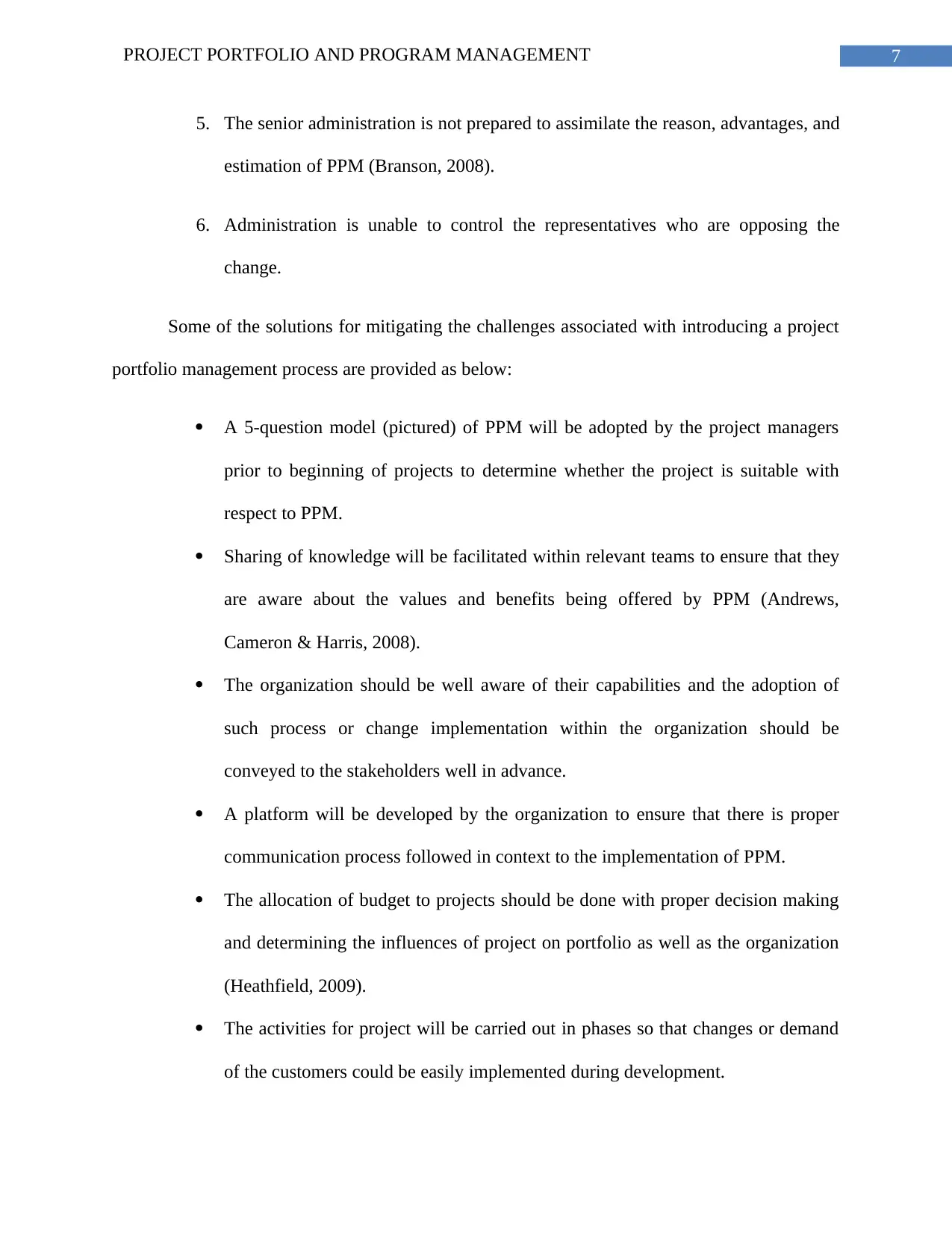
7PROJECT PORTFOLIO AND PROGRAM MANAGEMENT
5. The senior administration is not prepared to assimilate the reason, advantages, and
estimation of PPM (Branson, 2008).
6. Administration is unable to control the representatives who are opposing the
change.
Some of the solutions for mitigating the challenges associated with introducing a project
portfolio management process are provided as below:
A 5-question model (pictured) of PPM will be adopted by the project managers
prior to beginning of projects to determine whether the project is suitable with
respect to PPM.
Sharing of knowledge will be facilitated within relevant teams to ensure that they
are aware about the values and benefits being offered by PPM (Andrews,
Cameron & Harris, 2008).
The organization should be well aware of their capabilities and the adoption of
such process or change implementation within the organization should be
conveyed to the stakeholders well in advance.
A platform will be developed by the organization to ensure that there is proper
communication process followed in context to the implementation of PPM.
The allocation of budget to projects should be done with proper decision making
and determining the influences of project on portfolio as well as the organization
(Heathfield, 2009).
The activities for project will be carried out in phases so that changes or demand
of the customers could be easily implemented during development.
5. The senior administration is not prepared to assimilate the reason, advantages, and
estimation of PPM (Branson, 2008).
6. Administration is unable to control the representatives who are opposing the
change.
Some of the solutions for mitigating the challenges associated with introducing a project
portfolio management process are provided as below:
A 5-question model (pictured) of PPM will be adopted by the project managers
prior to beginning of projects to determine whether the project is suitable with
respect to PPM.
Sharing of knowledge will be facilitated within relevant teams to ensure that they
are aware about the values and benefits being offered by PPM (Andrews,
Cameron & Harris, 2008).
The organization should be well aware of their capabilities and the adoption of
such process or change implementation within the organization should be
conveyed to the stakeholders well in advance.
A platform will be developed by the organization to ensure that there is proper
communication process followed in context to the implementation of PPM.
The allocation of budget to projects should be done with proper decision making
and determining the influences of project on portfolio as well as the organization
(Heathfield, 2009).
The activities for project will be carried out in phases so that changes or demand
of the customers could be easily implemented during development.
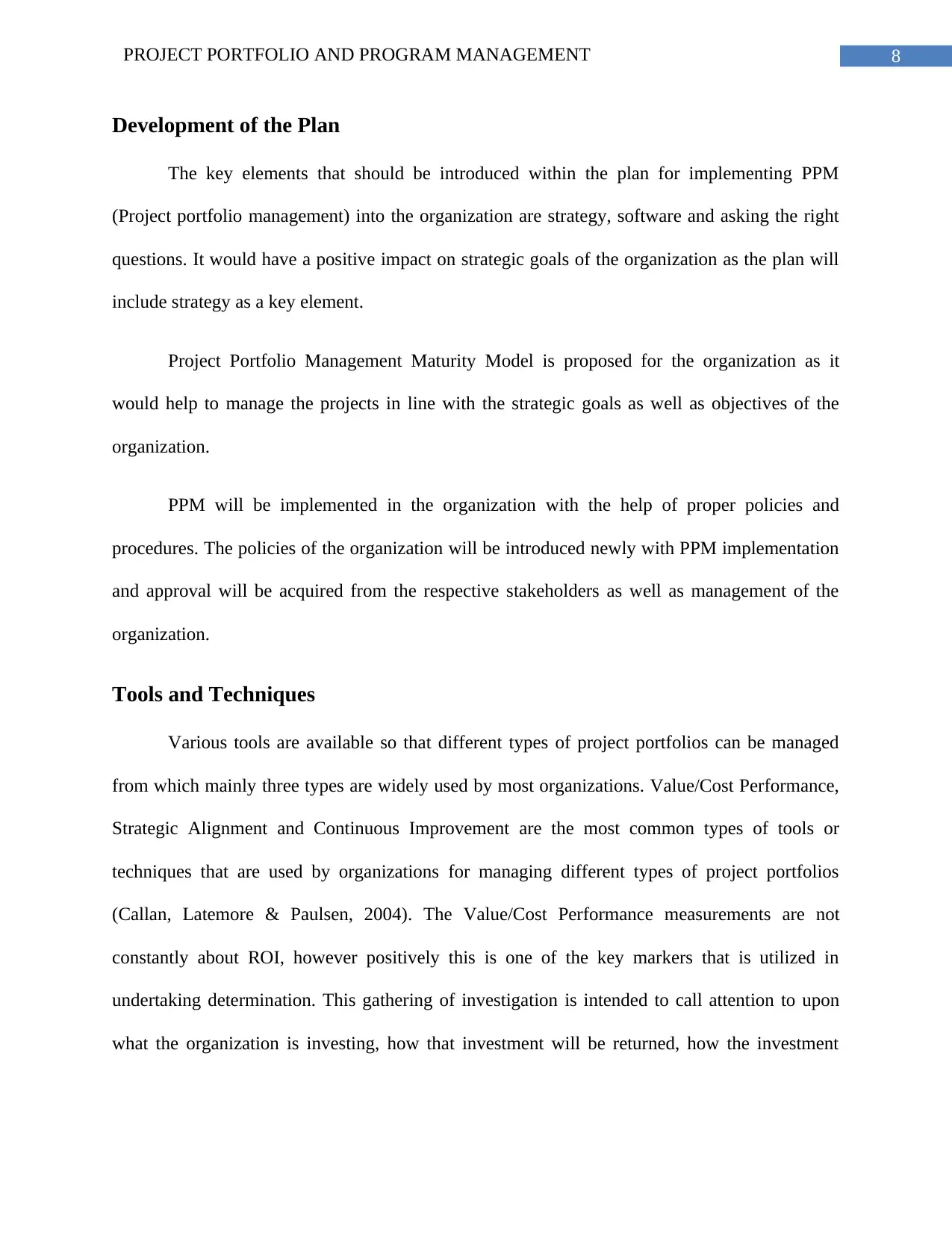
8PROJECT PORTFOLIO AND PROGRAM MANAGEMENT
Development of the Plan
The key elements that should be introduced within the plan for implementing PPM
(Project portfolio management) into the organization are strategy, software and asking the right
questions. It would have a positive impact on strategic goals of the organization as the plan will
include strategy as a key element.
Project Portfolio Management Maturity Model is proposed for the organization as it
would help to manage the projects in line with the strategic goals as well as objectives of the
organization.
PPM will be implemented in the organization with the help of proper policies and
procedures. The policies of the organization will be introduced newly with PPM implementation
and approval will be acquired from the respective stakeholders as well as management of the
organization.
Tools and Techniques
Various tools are available so that different types of project portfolios can be managed
from which mainly three types are widely used by most organizations. Value/Cost Performance,
Strategic Alignment and Continuous Improvement are the most common types of tools or
techniques that are used by organizations for managing different types of project portfolios
(Callan, Latemore & Paulsen, 2004). The Value/Cost Performance measurements are not
constantly about ROI, however positively this is one of the key markers that is utilized in
undertaking determination. This gathering of investigation is intended to call attention to upon
what the organization is investing, how that investment will be returned, how the investment
Development of the Plan
The key elements that should be introduced within the plan for implementing PPM
(Project portfolio management) into the organization are strategy, software and asking the right
questions. It would have a positive impact on strategic goals of the organization as the plan will
include strategy as a key element.
Project Portfolio Management Maturity Model is proposed for the organization as it
would help to manage the projects in line with the strategic goals as well as objectives of the
organization.
PPM will be implemented in the organization with the help of proper policies and
procedures. The policies of the organization will be introduced newly with PPM implementation
and approval will be acquired from the respective stakeholders as well as management of the
organization.
Tools and Techniques
Various tools are available so that different types of project portfolios can be managed
from which mainly three types are widely used by most organizations. Value/Cost Performance,
Strategic Alignment and Continuous Improvement are the most common types of tools or
techniques that are used by organizations for managing different types of project portfolios
(Callan, Latemore & Paulsen, 2004). The Value/Cost Performance measurements are not
constantly about ROI, however positively this is one of the key markers that is utilized in
undertaking determination. This gathering of investigation is intended to call attention to upon
what the organization is investing, how that investment will be returned, how the investment
⊘ This is a preview!⊘
Do you want full access?
Subscribe today to unlock all pages.

Trusted by 1+ million students worldwide
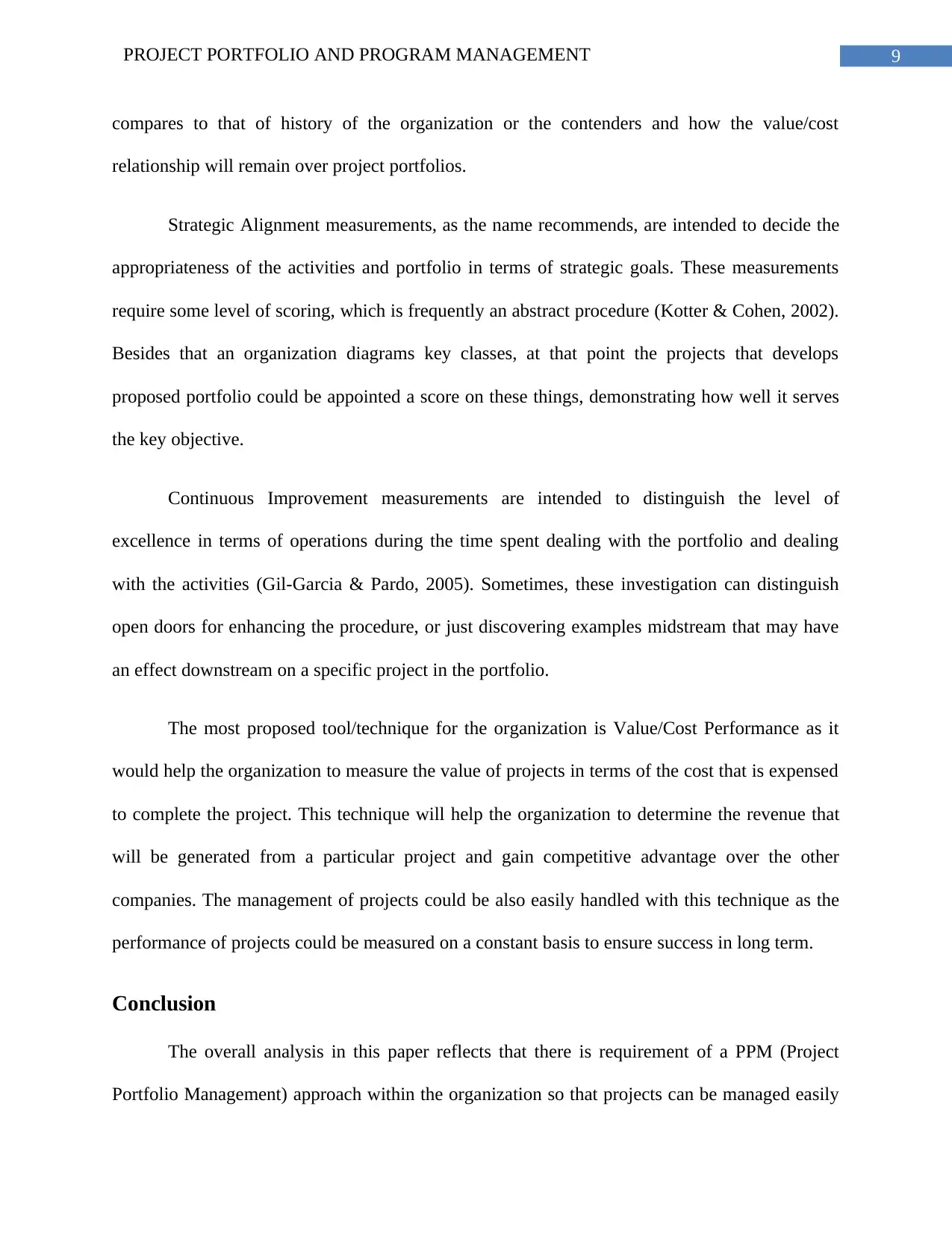
9PROJECT PORTFOLIO AND PROGRAM MANAGEMENT
compares to that of history of the organization or the contenders and how the value/cost
relationship will remain over project portfolios.
Strategic Alignment measurements, as the name recommends, are intended to decide the
appropriateness of the activities and portfolio in terms of strategic goals. These measurements
require some level of scoring, which is frequently an abstract procedure (Kotter & Cohen, 2002).
Besides that an organization diagrams key classes, at that point the projects that develops
proposed portfolio could be appointed a score on these things, demonstrating how well it serves
the key objective.
Continuous Improvement measurements are intended to distinguish the level of
excellence in terms of operations during the time spent dealing with the portfolio and dealing
with the activities (Gil-Garcia & Pardo, 2005). Sometimes, these investigation can distinguish
open doors for enhancing the procedure, or just discovering examples midstream that may have
an effect downstream on a specific project in the portfolio.
The most proposed tool/technique for the organization is Value/Cost Performance as it
would help the organization to measure the value of projects in terms of the cost that is expensed
to complete the project. This technique will help the organization to determine the revenue that
will be generated from a particular project and gain competitive advantage over the other
companies. The management of projects could be also easily handled with this technique as the
performance of projects could be measured on a constant basis to ensure success in long term.
Conclusion
The overall analysis in this paper reflects that there is requirement of a PPM (Project
Portfolio Management) approach within the organization so that projects can be managed easily
compares to that of history of the organization or the contenders and how the value/cost
relationship will remain over project portfolios.
Strategic Alignment measurements, as the name recommends, are intended to decide the
appropriateness of the activities and portfolio in terms of strategic goals. These measurements
require some level of scoring, which is frequently an abstract procedure (Kotter & Cohen, 2002).
Besides that an organization diagrams key classes, at that point the projects that develops
proposed portfolio could be appointed a score on these things, demonstrating how well it serves
the key objective.
Continuous Improvement measurements are intended to distinguish the level of
excellence in terms of operations during the time spent dealing with the portfolio and dealing
with the activities (Gil-Garcia & Pardo, 2005). Sometimes, these investigation can distinguish
open doors for enhancing the procedure, or just discovering examples midstream that may have
an effect downstream on a specific project in the portfolio.
The most proposed tool/technique for the organization is Value/Cost Performance as it
would help the organization to measure the value of projects in terms of the cost that is expensed
to complete the project. This technique will help the organization to determine the revenue that
will be generated from a particular project and gain competitive advantage over the other
companies. The management of projects could be also easily handled with this technique as the
performance of projects could be measured on a constant basis to ensure success in long term.
Conclusion
The overall analysis in this paper reflects that there is requirement of a PPM (Project
Portfolio Management) approach within the organization so that projects can be managed easily
Paraphrase This Document
Need a fresh take? Get an instant paraphrase of this document with our AI Paraphraser
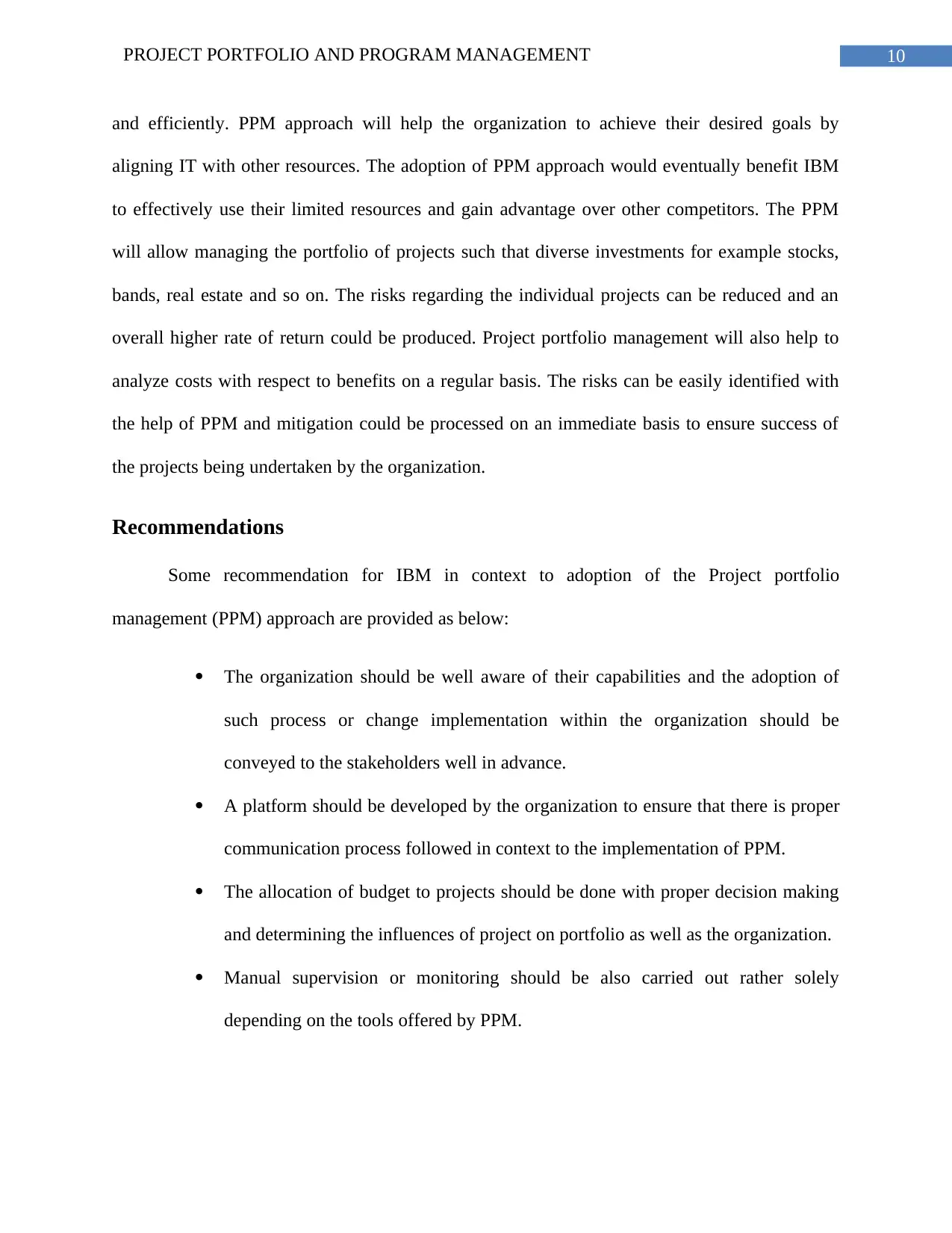
10PROJECT PORTFOLIO AND PROGRAM MANAGEMENT
and efficiently. PPM approach will help the organization to achieve their desired goals by
aligning IT with other resources. The adoption of PPM approach would eventually benefit IBM
to effectively use their limited resources and gain advantage over other competitors. The PPM
will allow managing the portfolio of projects such that diverse investments for example stocks,
bands, real estate and so on. The risks regarding the individual projects can be reduced and an
overall higher rate of return could be produced. Project portfolio management will also help to
analyze costs with respect to benefits on a regular basis. The risks can be easily identified with
the help of PPM and mitigation could be processed on an immediate basis to ensure success of
the projects being undertaken by the organization.
Recommendations
Some recommendation for IBM in context to adoption of the Project portfolio
management (PPM) approach are provided as below:
The organization should be well aware of their capabilities and the adoption of
such process or change implementation within the organization should be
conveyed to the stakeholders well in advance.
A platform should be developed by the organization to ensure that there is proper
communication process followed in context to the implementation of PPM.
The allocation of budget to projects should be done with proper decision making
and determining the influences of project on portfolio as well as the organization.
Manual supervision or monitoring should be also carried out rather solely
depending on the tools offered by PPM.
and efficiently. PPM approach will help the organization to achieve their desired goals by
aligning IT with other resources. The adoption of PPM approach would eventually benefit IBM
to effectively use their limited resources and gain advantage over other competitors. The PPM
will allow managing the portfolio of projects such that diverse investments for example stocks,
bands, real estate and so on. The risks regarding the individual projects can be reduced and an
overall higher rate of return could be produced. Project portfolio management will also help to
analyze costs with respect to benefits on a regular basis. The risks can be easily identified with
the help of PPM and mitigation could be processed on an immediate basis to ensure success of
the projects being undertaken by the organization.
Recommendations
Some recommendation for IBM in context to adoption of the Project portfolio
management (PPM) approach are provided as below:
The organization should be well aware of their capabilities and the adoption of
such process or change implementation within the organization should be
conveyed to the stakeholders well in advance.
A platform should be developed by the organization to ensure that there is proper
communication process followed in context to the implementation of PPM.
The allocation of budget to projects should be done with proper decision making
and determining the influences of project on portfolio as well as the organization.
Manual supervision or monitoring should be also carried out rather solely
depending on the tools offered by PPM.
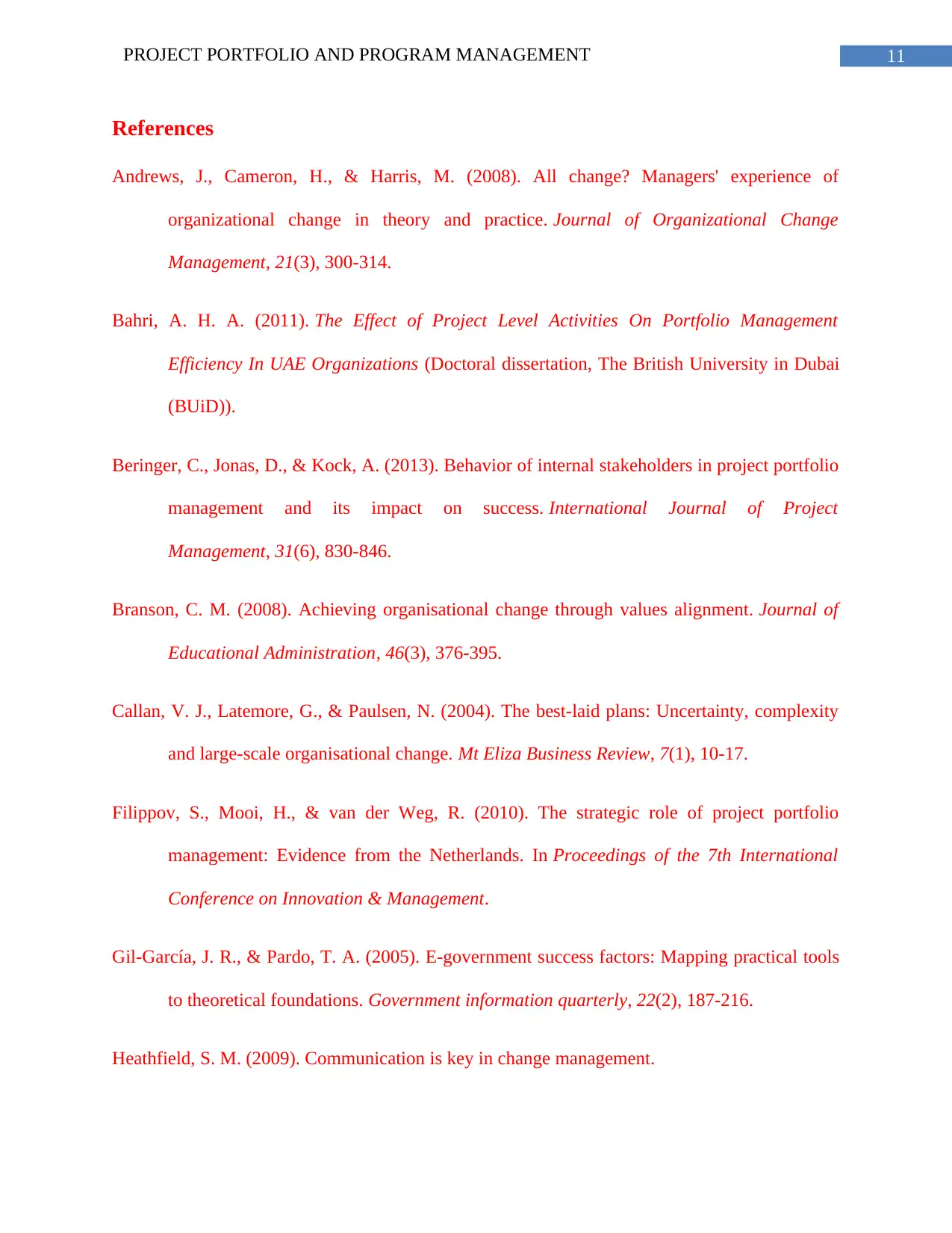
11PROJECT PORTFOLIO AND PROGRAM MANAGEMENT
References
Andrews, J., Cameron, H., & Harris, M. (2008). All change? Managers' experience of
organizational change in theory and practice. Journal of Organizational Change
Management, 21(3), 300-314.
Bahri, A. H. A. (2011). The Effect of Project Level Activities On Portfolio Management
Efficiency In UAE Organizations (Doctoral dissertation, The British University in Dubai
(BUiD)).
Beringer, C., Jonas, D., & Kock, A. (2013). Behavior of internal stakeholders in project portfolio
management and its impact on success. International Journal of Project
Management, 31(6), 830-846.
Branson, C. M. (2008). Achieving organisational change through values alignment. Journal of
Educational Administration, 46(3), 376-395.
Callan, V. J., Latemore, G., & Paulsen, N. (2004). The best-laid plans: Uncertainty, complexity
and large-scale organisational change. Mt Eliza Business Review, 7(1), 10-17.
Filippov, S., Mooi, H., & van der Weg, R. (2010). The strategic role of project portfolio
management: Evidence from the Netherlands. In Proceedings of the 7th International
Conference on Innovation & Management.
Gil-García, J. R., & Pardo, T. A. (2005). E-government success factors: Mapping practical tools
to theoretical foundations. Government information quarterly, 22(2), 187-216.
Heathfield, S. M. (2009). Communication is key in change management.
References
Andrews, J., Cameron, H., & Harris, M. (2008). All change? Managers' experience of
organizational change in theory and practice. Journal of Organizational Change
Management, 21(3), 300-314.
Bahri, A. H. A. (2011). The Effect of Project Level Activities On Portfolio Management
Efficiency In UAE Organizations (Doctoral dissertation, The British University in Dubai
(BUiD)).
Beringer, C., Jonas, D., & Kock, A. (2013). Behavior of internal stakeholders in project portfolio
management and its impact on success. International Journal of Project
Management, 31(6), 830-846.
Branson, C. M. (2008). Achieving organisational change through values alignment. Journal of
Educational Administration, 46(3), 376-395.
Callan, V. J., Latemore, G., & Paulsen, N. (2004). The best-laid plans: Uncertainty, complexity
and large-scale organisational change. Mt Eliza Business Review, 7(1), 10-17.
Filippov, S., Mooi, H., & van der Weg, R. (2010). The strategic role of project portfolio
management: Evidence from the Netherlands. In Proceedings of the 7th International
Conference on Innovation & Management.
Gil-García, J. R., & Pardo, T. A. (2005). E-government success factors: Mapping practical tools
to theoretical foundations. Government information quarterly, 22(2), 187-216.
Heathfield, S. M. (2009). Communication is key in change management.
⊘ This is a preview!⊘
Do you want full access?
Subscribe today to unlock all pages.

Trusted by 1+ million students worldwide
1 out of 13
Related Documents
Your All-in-One AI-Powered Toolkit for Academic Success.
+13062052269
info@desklib.com
Available 24*7 on WhatsApp / Email
![[object Object]](/_next/static/media/star-bottom.7253800d.svg)
Unlock your academic potential
Copyright © 2020–2025 A2Z Services. All Rights Reserved. Developed and managed by ZUCOL.




